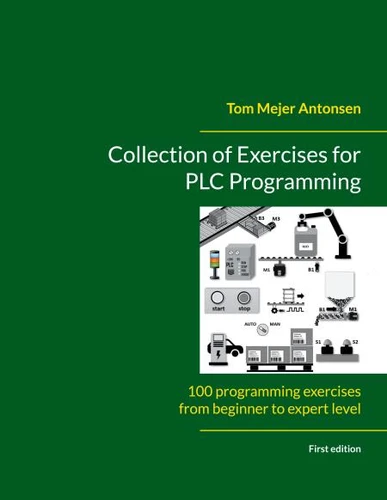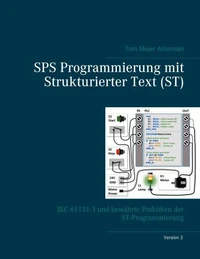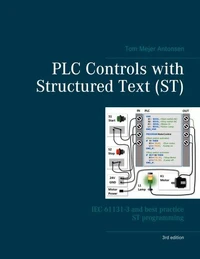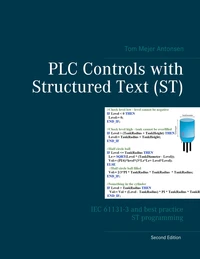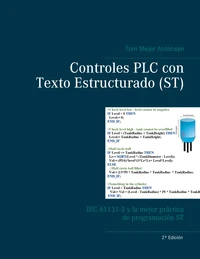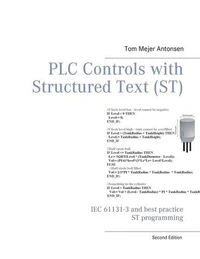Collection of Exercises for PLC Programming. 100 programming exercises from beginner to expert level
Par :Formats :
Disponible dans votre compte client Decitre ou Furet du Nord dès validation de votre commande. Le format PDF est :
- Compatible avec une lecture sur My Vivlio (smartphone, tablette, ordinateur)
- Compatible avec une lecture sur liseuses Vivlio
- Pour les liseuses autres que Vivlio, vous devez utiliser le logiciel Adobe Digital Edition. Non compatible avec la lecture sur les liseuses Kindle, Remarkable et Sony
 , qui est-ce ?
, qui est-ce ?Notre partenaire de plateforme de lecture numérique où vous retrouverez l'ensemble de vos ebooks gratuitement
Pour en savoir plus sur nos ebooks, consultez notre aide en ligne ici
- Nombre de pages104
- FormatPDF
- ISBN978-87-430-2259-6
- EAN9788743022596
- Date de parution17/06/2024
- Protection num.Digital Watermarking
- Taille12 Mo
- Infos supplémentairespdf
- ÉditeurBooks on demand
Résumé
This book contains more than 100 exercises for learning how to program programmable logic controllers (PLCs). At the same time, the exercises provide knowledge of how equipment, machines and small plants can be automated.
There are exercises at beginner level with logic, counters, and timers. Then there are exercises with ARRAY, STRUCT, STRING, as well as exercises with mathematics, functions, function blocks, program design, sorting, FIFO, and data collection.
Some exercises include selecting sensors, sequence techniques, manual/automatic operation, and data communication to a robot, frequency converter, or vision camera. The exercises start with easy ones and get harder as you go along. You can begin with simple exercises and gradually move on to more challenging ones that require a range of methods and programming skills. The exercises are based on relevant, real-world automation problems. The exercises can be solved in all types of PLCs, regardless of brand, hardware, or model.
There are enough exercises for at least 400 hours of homework! The book is designed for use in educational programs or training that include PLC programming, such as automation technician, electrician, automation engineer, or mechatronics engineer. Of course, the exercises can also be used for other educational programs that teach basic programming or automation. The author is an experienced engineer and senior lecturer with over 30 years of experience in software development.
He has been teaching PLC programming at the Dania Academy in Denmark for more than seven years. The author has published several books and sold more than 10, 000 copies.
Some exercises include selecting sensors, sequence techniques, manual/automatic operation, and data communication to a robot, frequency converter, or vision camera. The exercises start with easy ones and get harder as you go along. You can begin with simple exercises and gradually move on to more challenging ones that require a range of methods and programming skills. The exercises are based on relevant, real-world automation problems. The exercises can be solved in all types of PLCs, regardless of brand, hardware, or model.
There are enough exercises for at least 400 hours of homework! The book is designed for use in educational programs or training that include PLC programming, such as automation technician, electrician, automation engineer, or mechatronics engineer. Of course, the exercises can also be used for other educational programs that teach basic programming or automation. The author is an experienced engineer and senior lecturer with over 30 years of experience in software development.
He has been teaching PLC programming at the Dania Academy in Denmark for more than seven years. The author has published several books and sold more than 10, 000 copies.
This book contains more than 100 exercises for learning how to program programmable logic controllers (PLCs). At the same time, the exercises provide knowledge of how equipment, machines and small plants can be automated.
There are exercises at beginner level with logic, counters, and timers. Then there are exercises with ARRAY, STRUCT, STRING, as well as exercises with mathematics, functions, function blocks, program design, sorting, FIFO, and data collection.
Some exercises include selecting sensors, sequence techniques, manual/automatic operation, and data communication to a robot, frequency converter, or vision camera. The exercises start with easy ones and get harder as you go along. You can begin with simple exercises and gradually move on to more challenging ones that require a range of methods and programming skills. The exercises are based on relevant, real-world automation problems. The exercises can be solved in all types of PLCs, regardless of brand, hardware, or model.
There are enough exercises for at least 400 hours of homework! The book is designed for use in educational programs or training that include PLC programming, such as automation technician, electrician, automation engineer, or mechatronics engineer. Of course, the exercises can also be used for other educational programs that teach basic programming or automation. The author is an experienced engineer and senior lecturer with over 30 years of experience in software development.
He has been teaching PLC programming at the Dania Academy in Denmark for more than seven years. The author has published several books and sold more than 10, 000 copies.
Some exercises include selecting sensors, sequence techniques, manual/automatic operation, and data communication to a robot, frequency converter, or vision camera. The exercises start with easy ones and get harder as you go along. You can begin with simple exercises and gradually move on to more challenging ones that require a range of methods and programming skills. The exercises are based on relevant, real-world automation problems. The exercises can be solved in all types of PLCs, regardless of brand, hardware, or model.
There are enough exercises for at least 400 hours of homework! The book is designed for use in educational programs or training that include PLC programming, such as automation technician, electrician, automation engineer, or mechatronics engineer. Of course, the exercises can also be used for other educational programs that teach basic programming or automation. The author is an experienced engineer and senior lecturer with over 30 years of experience in software development.
He has been teaching PLC programming at the Dania Academy in Denmark for more than seven years. The author has published several books and sold more than 10, 000 copies.

